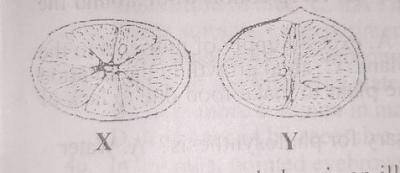
A. hesperidium
B. capsule
C. drupe
D. cypsela
Correct Answer:
Option A – hesperidium
Explanation:
Citrus fruits are classified as a hesperidium. Hesperidium is a modified berry resulting from a single ovary. The fruit consists of 8–16 carpels that form the core of the fruit or segments that contain the seeds and juice. Citrus fruits are characterized by the presence of an outer rind or skin. The rind or peel of citrus fruits is divided into an exocarp or flavedo, which is the outer, colored part, and the mesocarp or albedo, which is the inner colorless (white) or sometimes tinted part.
The flavedo consists of the epicarp proper, hypodermis, outer mesocarp, and oil glands. Above the epicarp is a multilayered protective skin or cuticle. The edible pulp of a mature citrus fruit is divided into segments with or without seeds or juice sacs by a thick film or endocarp surrounding the soft central axis.
Each segment is surrounded by a continuous endocarp membrane. In the segments, juice is contained in closely packed, club-shaped multicellular sacs, also called juice vesicles, which completely fill the segments. A thin wall called the carpellary septum surrounds the segments. Each juice sac also has a very minute oil gland at the center. The seeds (ovules) are also attached to segment walls by means of axial placentation.





